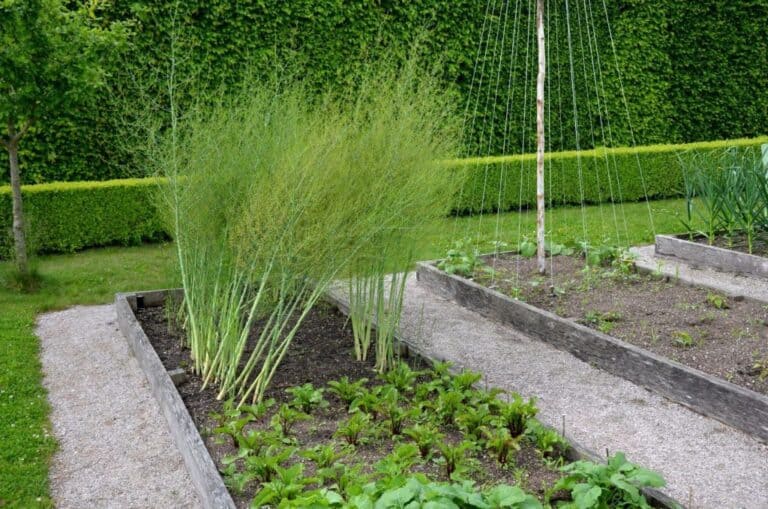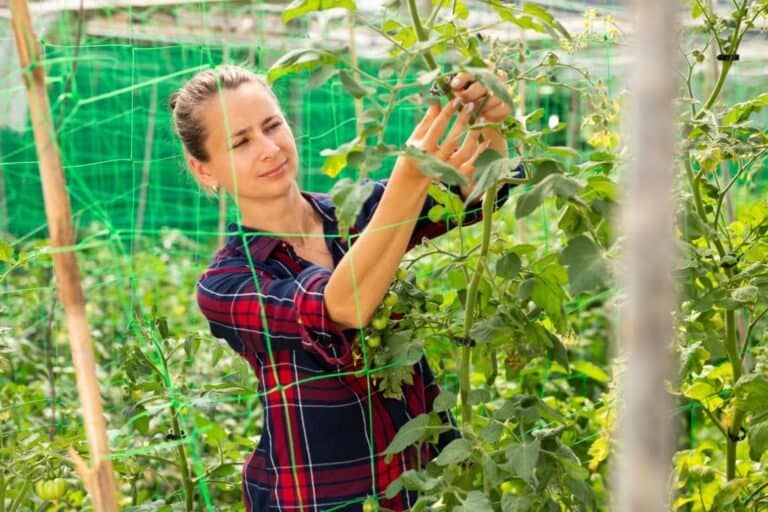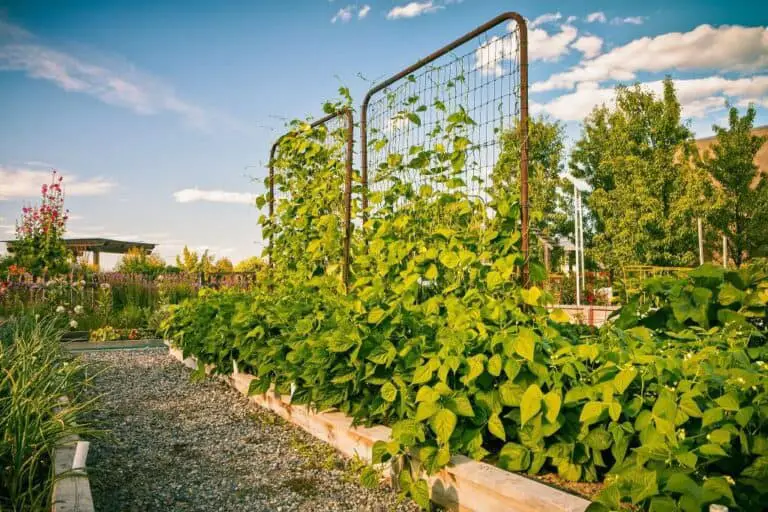How Far Apart to Plant Cantaloupe? How Much Spacing Area Needed?
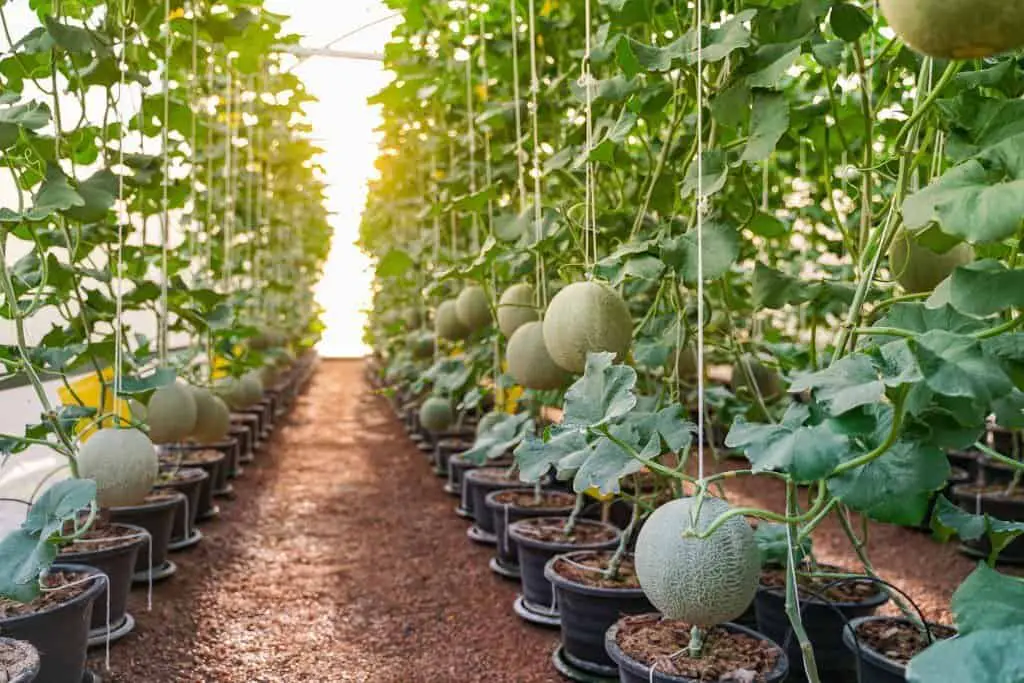
If you’re like me, you love cantaloupe. Not only is it delicious, but it’s also a great source of nutrients. And if you’re like me, you may also have a hard time getting your cantaloupe plants to produce their maximum fruit yield.
The cantaloupe plant, sometimes known as muskmelon, is a popular melon that is commonly cultivated in home and commercial gardens. The juicy orange flesh and net-like skin make it a very easy fruit to spot. Cantaloupes are related to cucumbers, squash, and pumpkins, so they need the same conditions to grow.
When cantaloupes are grown in an open field, the vines can cover a large area. To get the best yields from your cantaloupes, you need to provide enough space for the vines to grow. One way to increase your chances of getting fruit is to plant your cantaloupes closer together. But how close together you plant them depends on many factors.
So, how far apart should cantaloupes be planted? Cantaloupe plants should be planted 18″ to 28” apart. If you want to grow larger cantaloupes, increase the spacing to 36 inches between plants and 6 feet between rows.
There are different spaces based on how the cantaloupe is planted: seedlings, direct sowing, and transplanting from indoors. There are more than just numbers, so let’s get to the details below.
How Far Apart Should Cantaloupes Be Planted?
Cantaloupe plants should be planted 18 inches apart in a row, with rows spaced about 5 feet apart. If directly sowing cantaloupe seeds, consider using a tighter spacing of 9–18 inches apart.
If you are transplanting seedlings from indoors, space them 18-28 inches apart. If planting from seed, plant seeds every 9′′ and then thin down to around 18′′ apart after plants sprout and are a few inches tall.
According to 7 different sources (5 universities and 2 scientific papers), the recommended plant spacing for cantaloupes ranges from 9 inches apart to 36 inches apart, with an average of the 7 sources being 19 inches apart. Row spacing is consistently recommended at about 5 feet apart.
The two scientific papers both show that tighter spacing leads to higher yields, with one of the studies getting double the cantaloupe yields two years in a row when comparing the lowest plant density spacing to the highest plant density.
| Source | How Far Apart to Plant Cantaloupe Recommendations | How Far Apart to Plant Rows of Cantaloupe Recommendations |
Illinois University | 18-24″ | At least 5′ |
| Penn State University | 24-30″ | 5-6′ |
| Oklahoma State | 12″ | 5-7′ |
| Tennessee University | 24-36″ | 5-6′ |
| University of Arizona | 9″ | 5-7′ |
| International Journal of Vegetable Science | 24″ | 40″ |
| American Society for Horticultural Science | 12″ | 3′ |
Cantaloupe Yields vs. Cantaloupe Plant Spacing – Scientific Papers From Horticultural Journals
When you are planning to grow cantaloupes, one of the decisions you have to make is how far apart to plant the cantaloupes. There is a trade-off between the yield you can expect from each plant and the number of plants you need to grow to get that yield.
If you want to increase yield production, you will need to plant the cantaloupes closer together. However, if you plant them too close together, they will compete for space and nutrients, which will reduce their yields.
A good compromise is to plant the cantaloupes based on the scientific papers’ study and the practical yields of other gardeners. This will give you good yields without causing the plants to compete with each other.
Study #1
A study published in the International Journal of Vegetable Science measured the yields of cantaloupe plants with different intra-row spacings. Spacing between rows remained constant at 100 cm and intra-row spacings were varied at 20, 40, 60, 80, and 100 cm between cantaloupe plants. 60 cm of spacing resulted in the best overall yield of cantaloupes. 60cm = 24inches.
Study #2
A study by the American Society for Horticultural Science grew also studied cantaloupe plant spacing vs. yields in two consecutive growing seasons.
During the first growth year, as plant density increased from 1.7 plants/m2 to 4.1 plants/m2 cantaloupe yields nearly doubled from 11 kg/m2 to 20 kg/m2.
Each year they had planting spaces of 1.7, 2.5, 3.3, and 4.1 plants per m2. (1m2 = 11 square feet).
During the second growth year, as plant density increased from 1.7 plants/m2 to 4.1 plants/m2 cantaloupe yields doubled from 21.9 kg/m2 to 44.3 kg/m2. 4.1 plants per m2 = 11 square feet/4 plants.
That equals 2.75 square feet per plant which could be spaced something like 12″ between plants and rows of 36″.
How Many Cantaloupe Plants Should I Plant in a Container?
You want 3-5 gallons of dirt in the pot per cantaloupe plant. So, if you have a 10 gallon pot, you’d want 2-3 cantaloupe plants, and if you’re using a 20 gallon pot, 4-6 cantaloupe plants per container. Plants can be arranged in shapes to maintain proper spacing: triangle, diamond, pentagon, and hexagon.
How Far Apart to Plant Cantaloupe in Raised Beds
In raised beds that are 4′ x 8′, I recommend planting cantaloupe every 12 inches along the 8′-long wall, giving the cantaloupe plants the 4′ width of the bed to grow into.
How Deep to Plant Cantaloupe Seeds
Plant cantaloupe seeds 1/4-1/2″ deep in starter trays or pots inside. If planting outdoors, plant seeds 1″ deep. If transplanting starter plants outside, bury the root ball with a 1″ of soil.
How Far Apart to Plant Cantaloupe – University Recommendations
Illinois University Extension recommends that cantaloupes be planted every 18 to 24 inches apart along rows, and that rows should be spaced at least 5 feet apart.
Penn State University Extension recommends that cantaloupes be started indoors for around 21 days and then spaced 24 to 30 inches apart in rows, with rows being spaced 5 to 6 feet apart. They say that the average farmer plants 2,200-4,200 cantaloupe plants per acre.
Oklahoma State University Cooperative Extension Service recommends direct seeding cantaloupes into the field every 6 to 8 inches apart and then thinning down to a cantaloupe plant every 12 inches. They say cantaloupe seeds should be planted 1/2″ to 3/4″ deep and that the raised beds, rows, should be space 60-84 inches apart.
Tennessee University Cooperative Extension Service believes that cantaloupes should be transplanted outside at least 2-3 feet apart within rows and that rows should be spaced 5-6 feet apart. Spacing cantaloupe plants 2 feet apart resulted in 4,356 plants per acre versus 3 feet apart at 2,904 plants per acre.
According to a scientific paper done by the College of Agriculture – University of Arizona, the best cantaloupe yields came with cantaloupe plants spaced 9 inches apart. The studies found that the distance between rows was different at their two grow sites.
In the Yuma area, larger beds up to 84 inches wide were ideal, and in the Salt River Valley, shorter beds around 60 inches wide were ideal. The idea is that you want to give the plant as much space as it can effectively fill without leaving unused space.
Planting Cantaloupes In Mounds
The University of Arizona paper mentioned above came to the conclusion that hilled or mounded plants did not use fertilizer and water as well as plants that were not shaped like hills or mounds. I have also found this to be the case in my garden. Growing plants in mounds, in my experience, leads to fewer plants in the same garden space.
Planting in a mounded row has the same advantages as planting in mounds or hills. Mounding soil leads to higher soil temperatures and better drainage.
How Does Plant Spacing Affect Yields?
The norm for plant yields and plant spacing is this. A higher plant density leads to fewer fruits per plant and smaller fruits. A higher plant density results in more fruit per plant and larger fruits. Somewhere in the middle, usually leaning towards tighter spacing, is the best plant spacing for yields.
Take corn, for example. Corn is an important crop, and the relationship between corn density and yield has been thoroughly studied. Most corn plants in a field will yield one ear of corn per plant. However, corn on the outside row of fields commonly has corn plants that have multiple ears.
The extra sunshine, and access to water and nutrients allow corn plants on the outside of fields to produce more than one ear.
Be that as it may, farmers still plant with a tight density that leads to an average of around one ear of corn per plant because this is what they’ve found to give them the best yields per acre.
Square Foot Gardening & Cantaloupes
Square foot gardening is a form of intensive gardening that helps use garden space efficiently. It is commonly used with raised beds and divides square foot spaces physically with small wood trim, irrigation hose, or metal fencing.
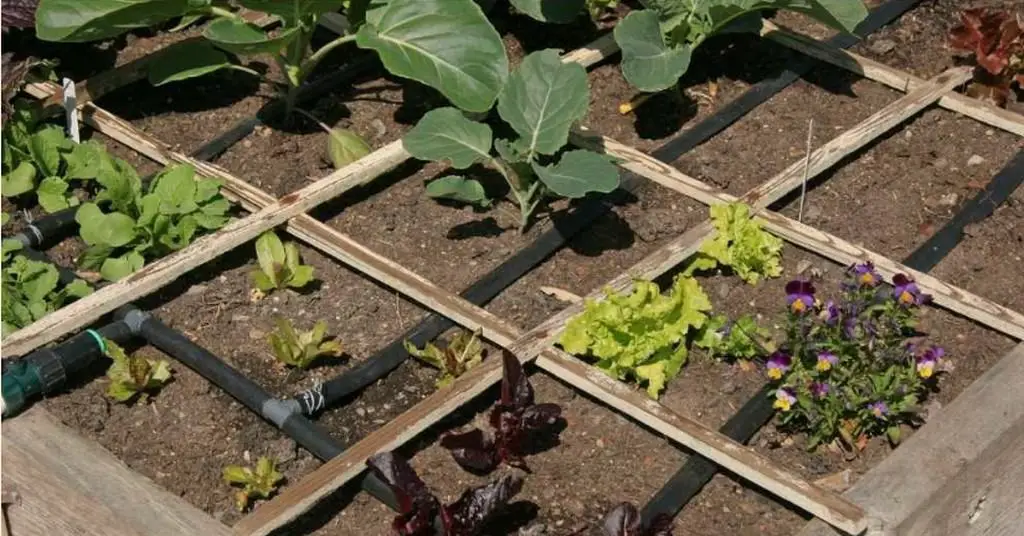
Square foot gardening takes the recommended plant spacing and uses that to determine how many of a specific plant, like cantaloupe, fit into a square foot. If we say the recommended spacing for a cantaloupe plant is 19 inches, then each cantaloupe plant will get 2 square feet.
This is close to the 2.75 square feet per plant that the earlier mentioned study published in the American Society for Horticultural Science found to give the best cantaloupe yields. However, 2 square feet is tight for a vining plant that typically grows to be 5 feet long and a trellis can be used to save space.
Factors that Affect Cantaloupe Growth
- Soil: The type of soil in which cantaloupe is planted can greatly impact its growth and yield. Cantaloupe prefers well-draining, sandy loam soil with a pH between 6.0 and 7.0. The soil should also be rich in organic matter and have adequate levels of nutrients, such as nitrogen, phosphorus, and potassium. If the soil is too heavy or clay-like, it may retain too much moisture, leading to root rot. If the soil is too sandy, it may not retain enough moisture, leading to dry, stunted plants.
- Water: Cantaloupe plants require consistent moisture to grow and produce fruit. They should be watered deeply and regularly, with the soil kept consistently moist but not waterlogged. Overwatering can lead to root rot and under watering can lead to fruit to be less sweet and flavorful.
- Sunlight: Cantaloupe plants require full sun to thrive, with at least 8 hours of direct sunlight per day. They also prefer warm temperatures, with ideal daytime temperatures between 75 and 90 degrees Fahrenheit. If the temperature is too hot or too cold, the plants may struggle to grow and produce fruit.
- Fertilizer: Cantaloupe plants require specific amounts of nutrients at specific times during cantaloupe growth cycle. They should be fertilized with a balanced fertilizer, such as 10-10-10, when the seedlings are about 3 weeks old, and again when the plants start to vine. They should also be fertilized with a high-potassium fertilizer, such as 0-0-60, when the fruits start to form. Over-fertilizing can lead to lush foliage but little fruit.
By knowing how these things affect cantaloupe growth, gardeners can change how they plant and care for their cantaloupes to get the best results.
The Optimal Growing Conditions for Cantaloupe
For the plant to produce a lot of high-quality cantaloupe fruit, it needs to grow in the best conditions. Cantaloupes are warm-season crops that thrive in temperatures between 80 and 82 °F (21-27 °C) and require a long growing season of about 80-90 days. They also require full sun and well-drained, fertile soil with a pH range of 6.0–6.88.
Cantaloupes need a steady supply of water and moist soil throughout the growing season so that the plant doesn’t get stressed out and the fruit tastes better. Irrigation should be applied as needed, and the soil should be kept evenly moist but not waterlogged. In hot places, it’s important to water the plants more during times of high heat so that the fruit doesn’t crack.
Fertilization is also an important aspect of growing cantaloupes. The plants require a balanced supply of nitrogen, phosphorus, and potassium. A soil test is recommended to determine the specific nutrient needs of the soil. A general recommendation is to apply a balanced fertilizer, such as 5-10-10, at a rate of 1-2 pounds per 100 square feet before planting, and again every 4-6 weeks during the growing season.
Cantaloupes are also sensitive to frost, so it’s important to wait until the soil has warmed up and the risk of frost has passed before planting seedlings. Since the fruits grow like vines, they also need to be trained and supported properly. This can be done by using a trellis, a support system, or even letting them grow on the ground.
Grow Cantaloupe With a Trellis To Save Space
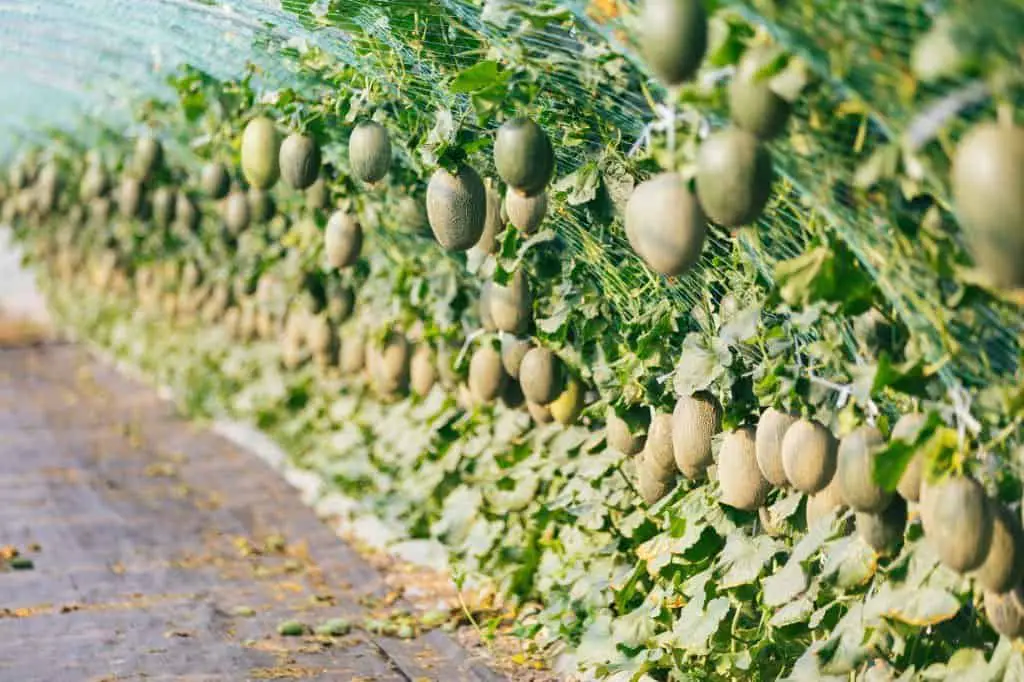
Growing cantaloupe plants with a trellis is a great way to save space and also has two other great benefits. On a trellis, the cantaloupe plant leaves get more sunlight, which can lead to greater yields and better tasting and more nutritious fruit. Air circulation is also increased, which leads to a lower chance of disease.
The tendrils on the cantaloupe plant are not strong enough to tie the plant securely to the trellis. This can cause the cantaloupe flowers to fall out, so garden ties need to be used.
Also, each cantaloupe fruit will need to be supported because the weight of the cantaloupes plus gravity will cause the fruits to fall off the vine before they are ripe.
The most common way of doing this in the garden is to fashion a small hammock with each end tied to the support for the fruit to sit in. You can use old t-shirts or whatever else you can think of.
Conclusions
When growing cantaloupes, there are a few things to consider in order to achieve the best yields. One of these considerations is the spacing of plants. Cantaloupes are vines that grow rapidly and need plenty of space to spread out. In general, the recommended spacing for cantaloupes is 3–4 feet between plants. If plants are too close together, they will compete for resources and produce fewer fruits. Conversely, if plants are too far apart, the yield per acre will be lower.
Another thing to consider when growing cantaloupes is the variety you choose. Some varieties grow taller than others and may need more space between plants. And finally, climate can also play a role in how much space is needed between plants. If you want to keep diseases from spreading, you might need more space in a hotter climate than in a cooler climate.




